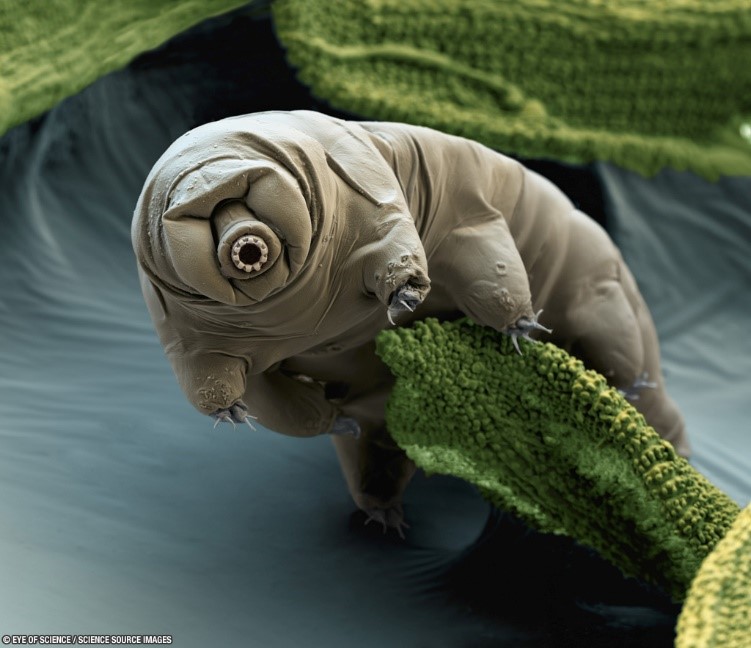 Tardigrades, also know as, “water bears” or “moss piglets” are the cute, baffling, and extremely durable organisms you can find in your own backyard. Likely due to their incredible resiliency water bears have been around for over 500 million years. These prehistoric multicellular microorganisms are a great point of research for microbiologists since their survival mechanisms are so robust. They have been able to survive temperatures up to 300 °F and as low as -458 °F which is close to absolute zero. Water bears have also been able to survive external pressures 6 times greater than those found in earth’s deepest ocean trenches, taken ionizing radiation at levels hundreds of times higher than what would be lethal for humans, and are the only known animal to have survived the vacuum and radiation of outer space. Another incredible adaptation of water bears is how they are able to slow their metabolism down to less than 0.01% of normal which allows their water content to drop to 1% of normal, this allows them to live while dehydrated for up to 10 years at a time.
Tardigrades, also know as, “water bears” or “moss piglets” are the cute, baffling, and extremely durable organisms you can find in your own backyard. Likely due to their incredible resiliency water bears have been around for over 500 million years. These prehistoric multicellular microorganisms are a great point of research for microbiologists since their survival mechanisms are so robust. They have been able to survive temperatures up to 300 °F and as low as -458 °F which is close to absolute zero. Water bears have also been able to survive external pressures 6 times greater than those found in earth’s deepest ocean trenches, taken ionizing radiation at levels hundreds of times higher than what would be lethal for humans, and are the only known animal to have survived the vacuum and radiation of outer space. Another incredible adaptation of water bears is how they are able to slow their metabolism down to less than 0.01% of normal which allows their water content to drop to 1% of normal, this allows them to live while dehydrated for up to 10 years at a time.
Being so resilient and able to thrive in tough environments means that water bears are very common. Water Bears live on all the worlds’ continents and are found at both high and low elevations in water or on moss and lichen. You could even find them right in your backyard!
To find a water bear at home you will need:
- A small container for soaking moss
- A transfer pipette (or an eye/medicine dropper)
- Microscope
- Microscope slide
- A microscope cover slide
Go outside and gather a small sample of moss. Place the moss sample in a small container and add a small amount of water as well. Leave the moss to soak for at least an hour. Then with the transfer pipette or clean eye/medicine dropper draw a small amount of water from the bottom of the container without disturbing the liquid. Drip the liquid onto the center of your microscope slide and to apply the cover slide place one side down on the edge of the liquid and lower the other side very slowly onto the liquid to avoid air bubbles. Carefully place the slide with your sample over the light of the microscope. Begin searching for water bears on the lowest power you should be able to see water bears at magnifications as low as 40X total on your microscope. They may not be moving right away because they may be just waking up from hibernation. Don’t be discouraged if you don’t find one in your first sample repeat the process until you get your very own water bear!
Being so common and so extraordinary water bears have found their way into pop culture appearing in films and shows such as Ant-Man, Ant-Man and the Wasp, Star Trek: Discovery, South Park, and Family Guy giving them some well-earned superstardom.
Image Credit & Copyright: Nicole Ottawa & Oliver Meckes / Eye of Science / Science Source Images

George Zell is a Marketing Intern at the Connecticut Science center where he produces and posts for some of the online content platforms. He is currently a senior working to get his Bachelors of Science in Business Marketing from the University of Hartford.



